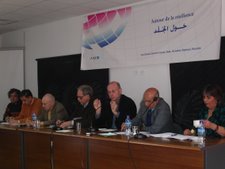Chercheur
Institut de santé Publique/Santé Communautaire
Université de Birzeit
Normalizing the Abnormal:
Palestinian Youth and Contradictions of Resilience in Protracted Conflict
This qualitative study explores the construct of resilience by Palestinian youth between 10th to 12th grades living in and around Ramallah in the West Bank. Using a constructionist approach, we look at how adolescents themselves interpret and give meaning to the concept of resilience in dehumanizing conditions. The findings show that family members and friends provide support and sustenance. Political participation and education are vital to a sense of identity and membership within the community. A seldom explored characteristic of adaptation lies in the normalization of everyday life. For Palestinian young people, ongoing efforts to normalize their lives foster resilience. A key to active coping is the accomplishment of everyday tasks at home and at school. These concrete and practical activities restore order and stability. Nonetheless, Palestinian young people paint a picture of resilience that is neither black nor white; their brushstrokes contain shades of grey indicating contradictory realities that lie at core of resilience. Far from being static, resilience reflects the tensions within their lives. Despite being labeled violent, Palestinian males in particular see political activism as a contra-point to humiliation and passivity. Despite a desire for normalcy, both male and female adolescents complain of emotional distress and boredom. Feelings of desperation and hopelessness are intermingled with optimism and dreams for the future. A key challenge to understanding resilience is to go beyond scientistic depictions of success stories to incorporate the voices of youth and their pathways to well being. This study raises questions of how concepts of resilience developed in predominantly Western urban settings ignore a local lexicon of suffering and endurance. Interventions for bolstering resilience cannot be replicated as a package without taking into account an interlocking of contextual, cultural and temporal processes.
فيت نغوين – غلهام
باحثة
معهد الصحة العامة والمجتمعية
جامعة بيرزيت
تحويل الشاذ إلى طبيعي:
الشباب الفلسطيني وتناقضات الجلد في صراع طويل
تبحث هذه الدراسة النوعية في بناء الجلد لدى الشباب الفلسطيني في الصفوف العاشر وحتى الثاني عشر المقيمين في رام الله بالضفة الغربية وحولها. باستخدام توجه بنائي ، فإننا ننظر إلى كيفية قيام الطلائع أنفسهم بتفسير مفهوم الجلد في ظروف تنزع الإنسانية وكيف يعطونه معنى. تبين الاستنتاجات أن أفراد الأسرة والأصدقاء يقدمون الدعم والمساندة. وتعتبر المشاركة السياسية والتعليم حيوية لخلق حس بالهوية والانتماء للمجتمع. أحد المواصفات للتكيف الذي تجاهل عادة تكمن في تطبيع الحياة اليومية. . بالنسبة للشباب الفلسطيني فإن الجهود المستمرة لتطبيع حياتهم تعزز من الجلد. من أساسيات التكيف الإيجابي هناك إنجاز مهام الحياة اليومية في البيت والمدرسة. فهذه النشاطات الملموسة والعملية تعيد النظام والاستقرار. ولكن الشباب الفلسطيني يرسم صورة للجلد لا هي بالسوداء ولا بالبيضاء؛ ففرشاة الرسم لديهم تحمل بعض ظلال اللون الرمادي الذي يشير إلى الحقائق المتناقضة التي تقبع في قلب الجلد. بعيدا عن البقاء ساكنا، فإن الجلد يعكس التوترات القائمة في حياتهم. رغم توصيفهم بالعنف، إلا أن الذكور الفلسطينيين بشكل خاص يعتبرون النشاط السياسي وزن مقابل للمهانة والسلبية. رغم الرغبة في الحياة الطبيعية، فإن الطلائع الذكور والإناث على حد سواء يشتكون من الإجهاد العاطفي ومن الملل. مشاعر اليأس وقلة الحيلة تتخالط مع التفاؤل وأحلام المستقبل. من التحديات الأساسية لفهم الجلد هو تخطي المواصفات شبه علمية عن قصص النجاح لدمج أصوات الشباب وطرقهم نحو السلامة. تثير هذه الدراسة أسئلة حول كيف أن مفاهيم الجلد التي تطورت أساسا في البيئات المدنية الغربية تتغاضى عن التعبير المحلي عن المعاناة والتحمل. عمليات التدخل لتعزيز الجلد لا يمكن تكرارها كرزمة واحدة بدون أن نأخذ بالحسبان التفاعلات ما بين عمليات السياق والثقافة والزمن.
باحثة
معهد الصحة العامة والمجتمعية
جامعة بيرزيت
تحويل الشاذ إلى طبيعي:
الشباب الفلسطيني وتناقضات الجلد في صراع طويل
تبحث هذه الدراسة النوعية في بناء الجلد لدى الشباب الفلسطيني في الصفوف العاشر وحتى الثاني عشر المقيمين في رام الله بالضفة الغربية وحولها. باستخدام توجه بنائي ، فإننا ننظر إلى كيفية قيام الطلائع أنفسهم بتفسير مفهوم الجلد في ظروف تنزع الإنسانية وكيف يعطونه معنى. تبين الاستنتاجات أن أفراد الأسرة والأصدقاء يقدمون الدعم والمساندة. وتعتبر المشاركة السياسية والتعليم حيوية لخلق حس بالهوية والانتماء للمجتمع. أحد المواصفات للتكيف الذي تجاهل عادة تكمن في تطبيع الحياة اليومية. . بالنسبة للشباب الفلسطيني فإن الجهود المستمرة لتطبيع حياتهم تعزز من الجلد. من أساسيات التكيف الإيجابي هناك إنجاز مهام الحياة اليومية في البيت والمدرسة. فهذه النشاطات الملموسة والعملية تعيد النظام والاستقرار. ولكن الشباب الفلسطيني يرسم صورة للجلد لا هي بالسوداء ولا بالبيضاء؛ ففرشاة الرسم لديهم تحمل بعض ظلال اللون الرمادي الذي يشير إلى الحقائق المتناقضة التي تقبع في قلب الجلد. بعيدا عن البقاء ساكنا، فإن الجلد يعكس التوترات القائمة في حياتهم. رغم توصيفهم بالعنف، إلا أن الذكور الفلسطينيين بشكل خاص يعتبرون النشاط السياسي وزن مقابل للمهانة والسلبية. رغم الرغبة في الحياة الطبيعية، فإن الطلائع الذكور والإناث على حد سواء يشتكون من الإجهاد العاطفي ومن الملل. مشاعر اليأس وقلة الحيلة تتخالط مع التفاؤل وأحلام المستقبل. من التحديات الأساسية لفهم الجلد هو تخطي المواصفات شبه علمية عن قصص النجاح لدمج أصوات الشباب وطرقهم نحو السلامة. تثير هذه الدراسة أسئلة حول كيف أن مفاهيم الجلد التي تطورت أساسا في البيئات المدنية الغربية تتغاضى عن التعبير المحلي عن المعاناة والتحمل. عمليات التدخل لتعزيز الجلد لا يمكن تكرارها كرزمة واحدة بدون أن نأخذ بالحسبان التفاعلات ما بين عمليات السياق والثقافة والزمن.

Aucun commentaire:
Enregistrer un commentaire